Multifunctional Zn(II) Coordination Polymer as Highly Selective Fluorescent Sensor and Adsorbent for Dyes
Abstract
1. Introduction
2. Results and Discussion
2.1. Structural Description of 1
2.2. Hirshfeld Surface Analysis
2.3. FTIR Spectroscopy
2.4. Thermal Studies
2.5. Electronic Absorption Spectroscopy
2.6. NMR Spectroscopy
2.7. Mass Spectrometry
2.8. Fluorescence Sensing Property
2.9. Detection of Metal Ions
2.10. Repeatability and Recyclability
2.11. Adsorption of Dyes
3. Materials and Methods
3.1. Starting Materials
3.2. Synthesis
3.2.1. Synthesis of the Schiff Base Ligand (SB)
3.2.2. Synthesis of the Zn(II) Complex (1)
3.3. Sensing and Dye Adsorption
3.4. X-ray Crystallography
4. Conclusions
Supplementary Materials
Author Contributions
Funding
Institutional Review Board Statement
Acknowledgments
Conflicts of Interest
References
- Tidwell, T.T. Hugo (Ugo) Schiff, Schiff Bases, and a Century of β-Lactam Synthesis. Angew. Chem. Int. Ed. 2008, 47, 1016–1020. [Google Scholar] [CrossRef] [PubMed]
- Malik, M.A.; Dar, O.A.; Gull, P.; Wani, M.Y.; Hashmi, A.A. Heterocyclic Schiff base transition metal complexes in antimicrobial and anticancer chemotherapy. MedChemComm 2018, 9, 409–436. [Google Scholar] [CrossRef] [PubMed]
- Jia, Y.; Li, J. Molecular Assembly of Schiff Base Interactions: Construction and Application. Chem. Rev. 2015, 115, 1597–1621. [Google Scholar] [CrossRef] [PubMed]
- Baleizão, C.; Garcia, H. Chiral Salen Complexes: An Overview to Recoverable and Reusable Homogeneous and Heterogeneous Catalysts. Chem. Rev. 2006, 106, 3987–4043. [Google Scholar] [CrossRef]
- Gao, F.; Zhang, Y.-Q.; Sun, W.; Liu, H.; Chen, X. Syntheses, structures and magnetic properties of macrocyclic Schiff base-supported homodinuclear lanthanide complexes. Dalton Trans. 2018, 47, 11696–11704. [Google Scholar] [CrossRef]
- Muddassir, M.; Alarifi, A.; Afzal, M.; Sepay, N. Newly designed Mn (III)–W(V) bimetallic assembly built by manganese (III) Schiff–base and octacyanotungstate(V) building blocks: Structural topologies, and magnetic features. Appl. Organomet. Chem. 2020, 34, e5914. [Google Scholar] [CrossRef]
- Andruh, M. Compartmental Schiff-base ligands—A rich library of tectons in designing magnetic and luminescent materials. Chem. Commun. 2011, 47, 3025–3042. [Google Scholar] [CrossRef]
- Berhanu, A.L.; Gaurav; Mohiuddin, I.; Malik, A.K.; Aulakh, J.S.; Kumar, V.; Kim, K.-H. Review of the applications of Schiff bases as optical chemical sensors. Trends Anal. Chem. 2019, 116, 74–91. [Google Scholar] [CrossRef]
- Baharuddin, A.A.; Ang, B.C.; Haseeb, A.S.M.A.; Wong, Y.C.; Wong, Y.H. Advances in chemiresistive sensors for acetone gas detection. Mater. Sci. Semicond. Process. 2019, 103, 104616. [Google Scholar] [CrossRef]
- Han, D.; Zhao, M.J. Facile and simple synthesis of novel iron oxide foam and used as acetone gas sensor with sub-ppm level. J. Alloys Compd. 2020, 815, 152406. [Google Scholar] [CrossRef]
- Morones-Ramirez, J.R.; Winkler, J.A.; Spina, C.S.; Collins, J.J. Silver Enhances Antibiotic Activity against Gram-Negative Bacteria. Sci. Transl. Med. 2013, 5, 190ra81. [Google Scholar] [CrossRef] [PubMed]
- Ruddaraju, L.K.; Pammi, S.V.N.; Guntuku, G.S.; Padavala, V.S.; Kolapalli, V.R.M. A review on anti-bacterials to combat resistance: From ancient era of plants and metals to present and future perspectives of green nano technological combinations. Asian J. Pharm. 2020, 15, 42–59. [Google Scholar] [CrossRef] [PubMed]
- Morganti, P.; Morganti, G.; Colao, C. Biofunctional Textiles for Aging Skin. Biomedicines 2019, 7, 51. [Google Scholar] [CrossRef] [PubMed]
- Wang, S.; Cong, T.; Liang, Q.; Li, Z.; Xu, S. A benzoindo-croconine based colorimetric and fluorescent chemosensor for detection Fe3+/Cu2+/Ag+ ions. Optik 2016, 127, 890–895. [Google Scholar] [CrossRef]
- Jiang, Y.; Kong, W.; Shen, Y.; Wang, B. Two fluorescence turn-on chemosensors based on pyrrolo[2,1-a]isoquinoline for detection of Ag+ in aqueous solution. Tetrahedron 2015, 71, 5584–5588. [Google Scholar] [CrossRef]
- Lai, C.-Z.; Fierke, M.A.; da Costa, R.C.; Gladysz, J.A.; Stein, A.; Bühlmann, P. Highly Selective Detection of Silver in the Low ppt Range with Ion-Selective Electrodes Based on Ionophore-Doped Fluorous Membranes. Anal. Chem. 2010, 82, 7634–7640. [Google Scholar] [CrossRef]
- Huang, S.; He, S.; Lu, Y.; Wei, F.; Zeng, X.; Zhao, L. Highly sensitive and selective fluorescent chemosensor for Ag+ based on a coumarin–Se2N chelating conjugate. Chem. Commun. 2011, 47, 2408–2410. [Google Scholar] [CrossRef]
- Zhang, X.-B.; Han, Z.-X.; Fang, Z.-H.; Shen, G.-L.; Yu, R.-Q. 5,10,15-Tris (pentafluorophenyl) corrole as highly selective neutral carrier for a silver ion-sensitive electrode. Anal. Chim. Acta 2006, 562, 210–215. [Google Scholar] [CrossRef]
- Velmurugan, K.; Vickram, R.; Karthick, R.; Jipsa, C.V.; Suresh, S.; Prabakaran, G.; Prabhu, J.; Velraj, G.; Nandhakumar, R. Binol diuryl dipyrene fluorescent probe: Dual detection of silver and carbonate ions and its bioimaging applications. J. Photochem. Photobiol. A Chem. 2020, 401, 112737. [Google Scholar] [CrossRef]
- Hua, J.A.; Zhao, Y.; Kang, Y.S.; Lu, Y.; Sun, W.Y. Solvent-dependent zinc (II) coordination polymers with mixed ligands: Selective sorption and fluorescence sensing. Dalton Trans. 2015, 44, 11524–11532. [Google Scholar] [CrossRef]
- Jin, H.; Xu, J.; Zhang, L.; Ma, B.; Shi, X.; Fan, Y.; Wang, L. Multi-responsive luminescent sensor based on Zn (II) metal-organic framework for selective sensing of Cr(III), Cr(VI) ions and p-nitrotolune. J. Solid State Chem. 2018, 268, 168–174. [Google Scholar] [CrossRef]
- Lu, L.; He, J.; Wang, J.; Wu, W.-P.; Li, B.; Singh, A.; Kumar, A.; Qin, X. Luminescent sensing and photocatalytic degradation in a new 3D Zn(II)-based highly luminescent metal−organic framework. J. Mol. Struct. 2019, 1179, 612–617. [Google Scholar] [CrossRef]
- Lustig, W.P.; Mukherjee, S.; Rudd, N.D.; Desai, A.V.; Li, J.; Ghosh, S.K. Metal–organic frameworks: Functional luminescent and photonic materials for sensing applications. Chem. Soc. Rev. 2017, 46, 3242–3285. [Google Scholar] [CrossRef] [PubMed]
- Ma, Y.; Xu, G.; Wei, F.; Cen, Y.; Song, Y.; Shi, M.; Xu, X.; Sohail, M.; Hu, Q. Fluorescent zinc(ii)-based metal–organic frameworks for nitroaromatics sensing. New J. Chem. 2018, 42, 5162–5167. [Google Scholar] [CrossRef]
- Song, J.-B.; Wang, P.; Yan, L.; Hao, L.; Khan, M.A.; Liu, G.-L.; Li, H. Crystal structures, red-shifted luminescence and iodide-anion recognition properties of four novel D–A type Zn(ii) complexes. Dalton Trans. 2020, 49, 4358–4368. [Google Scholar] [CrossRef]
- Li, Y.L.; Zhao, Y.; Wang, P.; Kang, Y.S.; Liu, Q.; Zhang, X.D.; Sun, W.Y. Multifunctional Metal–Organic Frameworks with Fluorescent Sensing and Selective Adsorption Properties. Inorg. Chem. 2016, 55, 11821–11830. [Google Scholar] [CrossRef]
- Li, Y.; Song, H.; Chen, Q.; Liu, K.; Zhao, F.-Y.; Ruan, W.-J.; Chang, Z. Two coordination polymers with enhanced ligand-centered luminescence and assembly imparted sensing ability for acetone. J. Mater. Chem. A 2014, 2, 9469–9473. [Google Scholar] [CrossRef]
- Muddassir, M.; Usman, M.; Alarifi, A.; Afzal, M.; Alshali, K.A.; Beagan, A.; Kumar, A.; Abduhd, N.A.Y.; Ahmad, M. Experimental Sensing and DFT Mechanism of Zn(II) Complex for Highly Sensitive and Selective Detection of Acetone. Crystals 2020, 10, 324. [Google Scholar] [CrossRef]
- Wang, J.; Zha, Q.; Qin, G.; Ni, Y. A novel Zn(II)-based metal-organic framework as a high selective and sensitive sensor for fluorescent detections of aromatic nitrophenols and antibiotic metronidazole. Talanta 2020, 211, 120742. [Google Scholar] [CrossRef]
- Zhang, X.; Luo, X.; Zhang, N.; Wu, J.; Huang, Y.-Q. A highly selective and sensitive Zn(ii) coordination polymer luminescent sensor for Al3+ and NACs in the aqueous phase. Inorg. Chem. Front. 2017, 4, 1888–1894. [Google Scholar] [CrossRef]
- Katz, M.J.; Sakai, K.; Leznoff, D.B. The use of aurophilic and other metal–metal interactions as crystal engineering design elements to increase structural dimensionality. Chem. Soc. Rev. 2008, 37, 1884–1895. [Google Scholar] [CrossRef] [PubMed]
- Spackman, M.A.; Jayatilaka, D. Hirshfeld surface analysis. CrystEngComm 2009, 11, 19–32. [Google Scholar] [CrossRef]
- Woińska, M.; Jayatilaka, D.; Spackman, M.A.; Edwards, A.J.; Dominiak, P.M.; Woźniak, K.; Nishibori, E.; Sugimoto, K.; Grabowsky, S. Hirshfeld atom refinement for modelling strong hydrogen bonds. Acta Crystallogr. A 2014, 70, 483–498. [Google Scholar] [CrossRef] [PubMed]
- Arjmand, F.; Muddassir, M. Design and synthesis of heterobimetallic topoisomerase I and II inhibitor complexes: In vitro DNA binding, interaction with 5′-GMP and 5′-TMP and cleavage studies. J. Photochem. Photobiol. B Biol. 2010, 101, 37–46. [Google Scholar] [CrossRef] [PubMed]
- Nakamoto, K. Infrared and Raman Spectra of Inorganic and Coordination Compounds; Wiley: New York, NY, USA, 1986. [Google Scholar]
- Arjmand, F.; Muddassir, M.; Khan, R.H. Chiral preference of l-tryptophan derived metal-based antitumor agent of late 3d-metal ions (Co(II), Cu(II) and Zn(II)) in comparison to d- and dl-tryptophan analogues: Their in vitro reactivity towards CT DNA, 5′-GMP and 5′-TMP. Eur. J. Med. Chem. 2010, 45, 3549–3557. [Google Scholar] [CrossRef] [PubMed]
- Arjmand, F.; Muddassir, M. A mechanistic approach for the DNA binding of chiral enantiomeric L- and D-tryptophan-derived metal complexes of 1,2-DACH: Cleavage and antitumor activity. Chirality 2011, 23, 250–259. [Google Scholar] [CrossRef]
- Heine, J.; Müller-Buschbaum, K. Engineering metal-based luminescence in coordination polymers and metal–organic frameworks. Chem. Soc. Rev. 2013, 42, 9232–9242. [Google Scholar] [CrossRef]
- Zheng, X.; Zhou, L.; Huang, Y.; Wang, C.; Duan, J.; Wen, L.; Tian, Z.; Li, D. A series of metal–organic frameworks based on 5-(4-pyridyl)-isophthalic acid: Selective sorption and fluorescence sensing. J. Mater. Chem. A 2014, 2, 12413–12422. [Google Scholar] [CrossRef]
- Chen, B.; Yang, Y.; Zapata, F.; Lin, G.; Qian, G.; Lobkovsky, E.B. Luminescent Open Metal Sites within a Metal–Organic Framework for Sensing Small Molecules. Adv. Mater. 2007, 19, 1693–1696. [Google Scholar] [CrossRef]
- Qu, K.; Wang, J.; Ren, J.; Qu, X. Carbon Dots Prepared by Hydrothermal Treatment of Dopamine as an Effective Fluorescent Sensing Platform for the Label-Free Detection of Iron(III) Ions and Dopamine. Chem.-Eur. J. 2013, 19, 7243–7249. [Google Scholar] [CrossRef]
- Yang, W.; Feng, J.; Zhang, H. Facile and rapid fabrication of nanostructured lanthanide coordination polymers as selective luminescent probes in aqueous solution. J. Mater. Chem. 2012, 22, 6819–6823. [Google Scholar] [CrossRef]
- Guo, Z.; Xu, H.; Su, S.; Cai, J.; Dang, S.; Xiang, S.; Qian, G.; Zhang, H.; O’Keeffe, M.; Chen, B. A robust near infrared luminescent ytterbium metal–organic framework for sensing of small molecules. Chem. Commun. 2011, 47, 5551–5553. [Google Scholar] [CrossRef] [PubMed]
- Pandey, R.; Kumar, P.; Singh, A.K.; Shahid, M.; Li, P.-Z.; Singh, S.K.; Xu, Q.; Misra, A.; Pandey, D.S. Fluorescent Zinc(II) Complex Exhibiting “On-Off-On” Switching Toward Cu2+ and Ag+ Ions. Inorg. Chem. 2011, 50, 3189–3197. [Google Scholar] [CrossRef] [PubMed]
- Lotfi, B.; Tarlani, A.; Akbari-Moghaddam, P.; Mirza-Aghayan, M.; Peyghan, A.A.; Muzart, J.; Zadmard, R. Multivalent calix[4]arene-based fluorescent sensor for detecting silver ions in aqueous media and physiological environment. Biosens. Bioelectron. 2017, 90, 290–297. [Google Scholar] [CrossRef] [PubMed]
- Wang, Z.-X.; Ding, S.-N. One-Pot Green Synthesis of High Quantum Yield Oxygen-Doped, Nitrogen-Rich, Photoluminescent Polymer Carbon Nanoribbons as an Effective Fluorescent Sensing Platform for Sensitive and Selective Detection of Silver(I) and Mercury(II) Ions. Anal. Chem. 2014, 86, 7436–7445. [Google Scholar] [CrossRef]
- Chen, P.-C.; Yeh, T.-Y.; Ou, C.-M.; Shih, C.-C.; Chang, H.-T. Synthesis of aluminum oxide supported fluorescent gold nanodots for the detection of silver ions. Nanoscale 2013, 5, 4691–4695. [Google Scholar] [CrossRef]
- Fox, B.S.; Beyer, M.K.; Bondybey, V.E. Coordination Chemistry of Silver Cations. J. Am. Chem. Soc. 2002, 124, 13613–13623. [Google Scholar] [CrossRef]
- Pardo, E.; Ruiz-García, R.; Lloret, F.; Julve, M.; Cano, J.; Pasán, J.; Ruiz-Pérez, C.; Filali, Y.; Chamoreau, L.-M.; Journaux, Y. Molecular-Programmed Self-Assembly of Homo- and Heterometallic Penta- and Hexanuclear Coordination Compounds: Synthesis, Crystal Structures, and Magnetic Properties of Ladder-Type CuII2MIIx (M = Cu, Ni; x = 3, 4) Oxamato Complexes with CuII2 Metallacyclophane Cores. Inorg. Chem. 2007, 46, 4504–4514. [Google Scholar]
- Palacios, M.A.; Rodríguez-Diéguez, A.; Sironi, A.; Herrera, J.M.; Mota, A.J.; Cano, J.; Colacio, E. Enhanced ferromagnetic interaction in metallacyclic complexes incorporating m-phenylenediamidato bridges. Dalton Trans. 2009, 40, 8538–8547. [Google Scholar] [CrossRef]
- Hernández-Molina, R.; Mederos, A.; Gili, P.; Domínguez, S.; Lloret, F.; Cano, J.; Julve, M.; Ruiz-Pérez, C.; Solans, X. Dimer species in dimethyl sulfoxide–water (80:20 w/w) solution of N,N′-bis(salicylideneimine)-m-phenylenediamine (H2sal-m-phen) and similar Schiff bases with CuII, NiII, CoII and ZnII. Crystal structure of [Co2(sal-m-phen)2]·CHCl3. J. Chem. Soc. Dalton Trans. 1997, 4327–4334. [Google Scholar] [CrossRef]
- Clarke, C.J.; Tu, W.-C.; Levers, O.; Bröhl, A.; Hallett, J.P. Green and Sustainable Solvents in Chemical Processes. Chem. Rev. 2018, 118, 747–800. [Google Scholar] [CrossRef] [PubMed]
- Ren, X.; Zeng, G.; Tang, L.; Wang, J.; Wan, J.; Liu, Y.; Yu, J.; Yi, H.; Ye, S.; Deng, R. Sorption, transport and biodegradation—An insight into bioavailability of persistent organic pollutants in soil. Sci. Total Environ. 2018, 610–611, 1154–1163. [Google Scholar] [CrossRef] [PubMed]
- Bourque, T.A.; Nelles, M.E.; Gullon, T.J.; Garon, C.N.; Ringer, M.K.; Leger, L.J.; Mason, J.W.; Wheaton, S.L.; Baerlocher, F.J.; Vogels, C.M.; et al. Late metal salicylaldimine complexes derived from 5-aminosalicylic acid Molecular structure of a zwitterionic mono Schiff base zinc complex. Can. J. Chem. 2005, 83, 1063. [Google Scholar] [CrossRef]
- Bruker. Apex3 v2016.9-0, Saint V8.34A, SAINT V8.37A, 2013/2014; Bruker AXS Inc.: Madison, WI, USA, 2016. [Google Scholar]
- SHELXTL Suite of Programs, Version 6.14, 2000–2003, Bruker Advanced X-ray Solutions; Bruker AXS Inc.: Madison, WI, USA, 2003.
- Sheldrick, G.M. A short history of SHELX. Acta Crystallogr. A 2008, 64, 112–122. [Google Scholar] [CrossRef]
- Sheldrick, G.M. (University of Göttingen, Germany). 2018.
- Sheldrick, G.M. Crystal structure refinement with SHELXL. Acta Crystallogr. Sect. C Struct. Chem. 2015, 71, 3–8. [Google Scholar] [CrossRef]
- Hübschle, C.B.; Sheldrick, G.M.; Dittrich, B. ShelXle: A Qt graphical user interface for SHELXL. J. Appl. Crystallogr. 2011, 44, 1281–1284. [Google Scholar] [CrossRef]
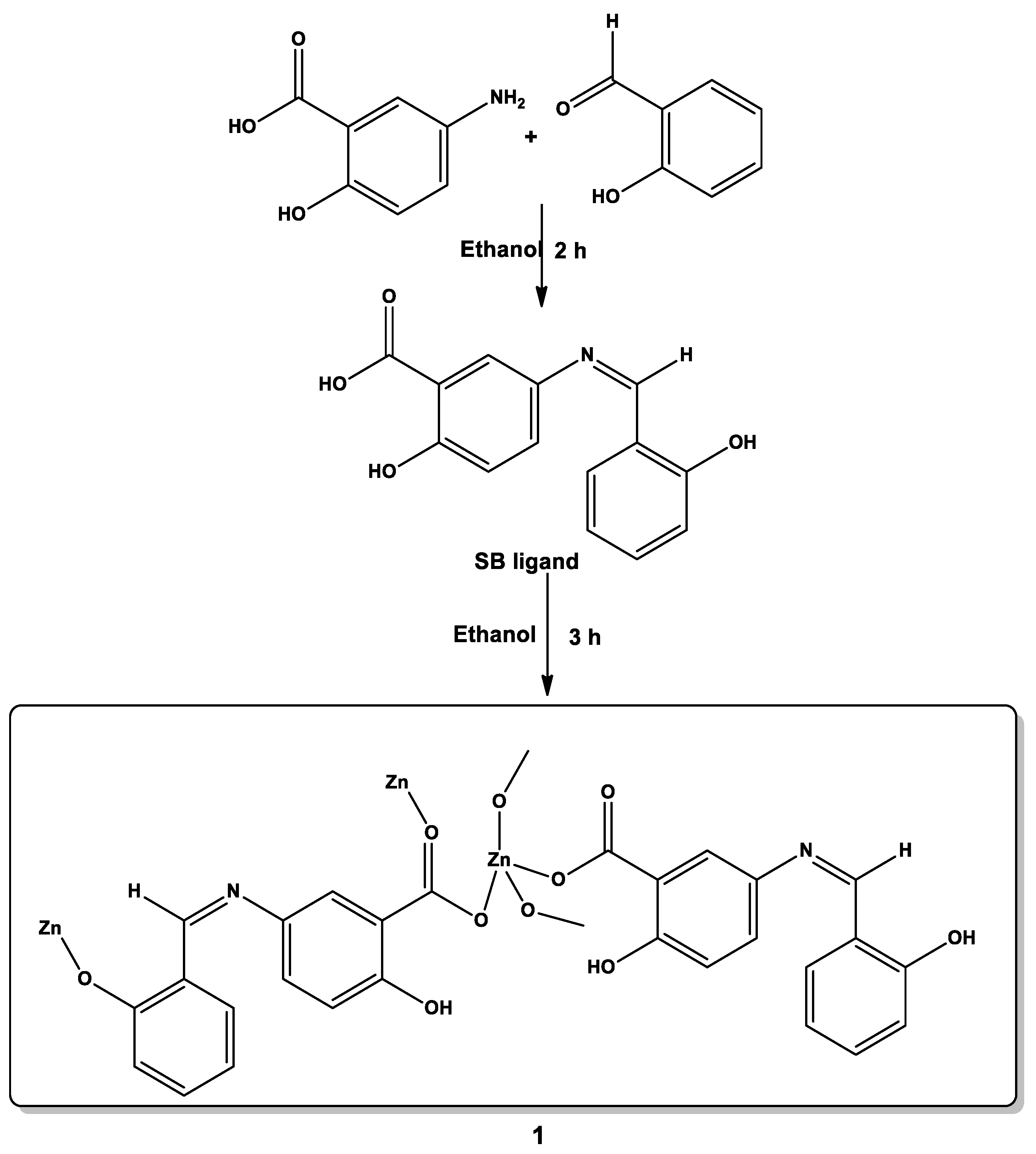
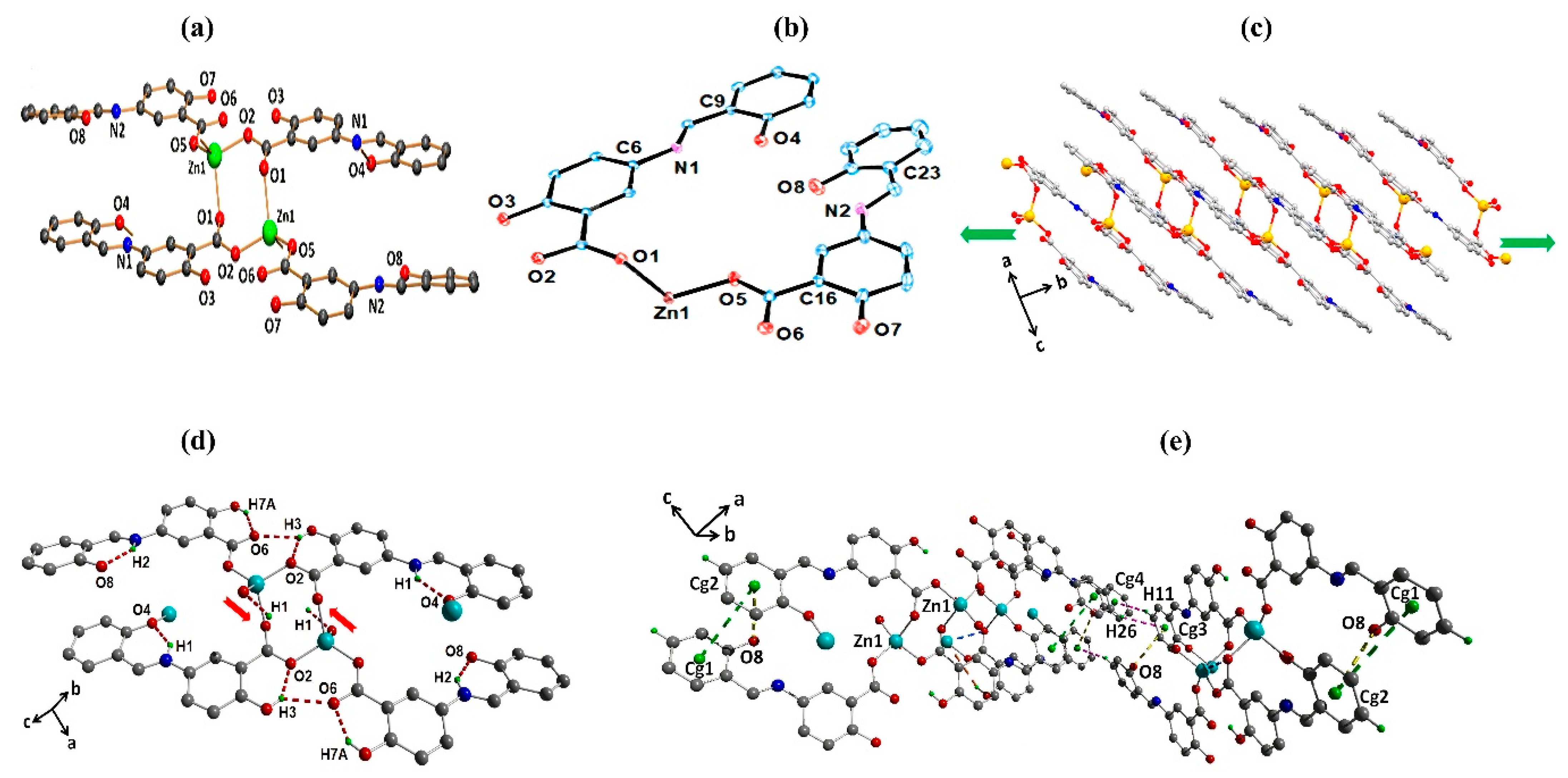
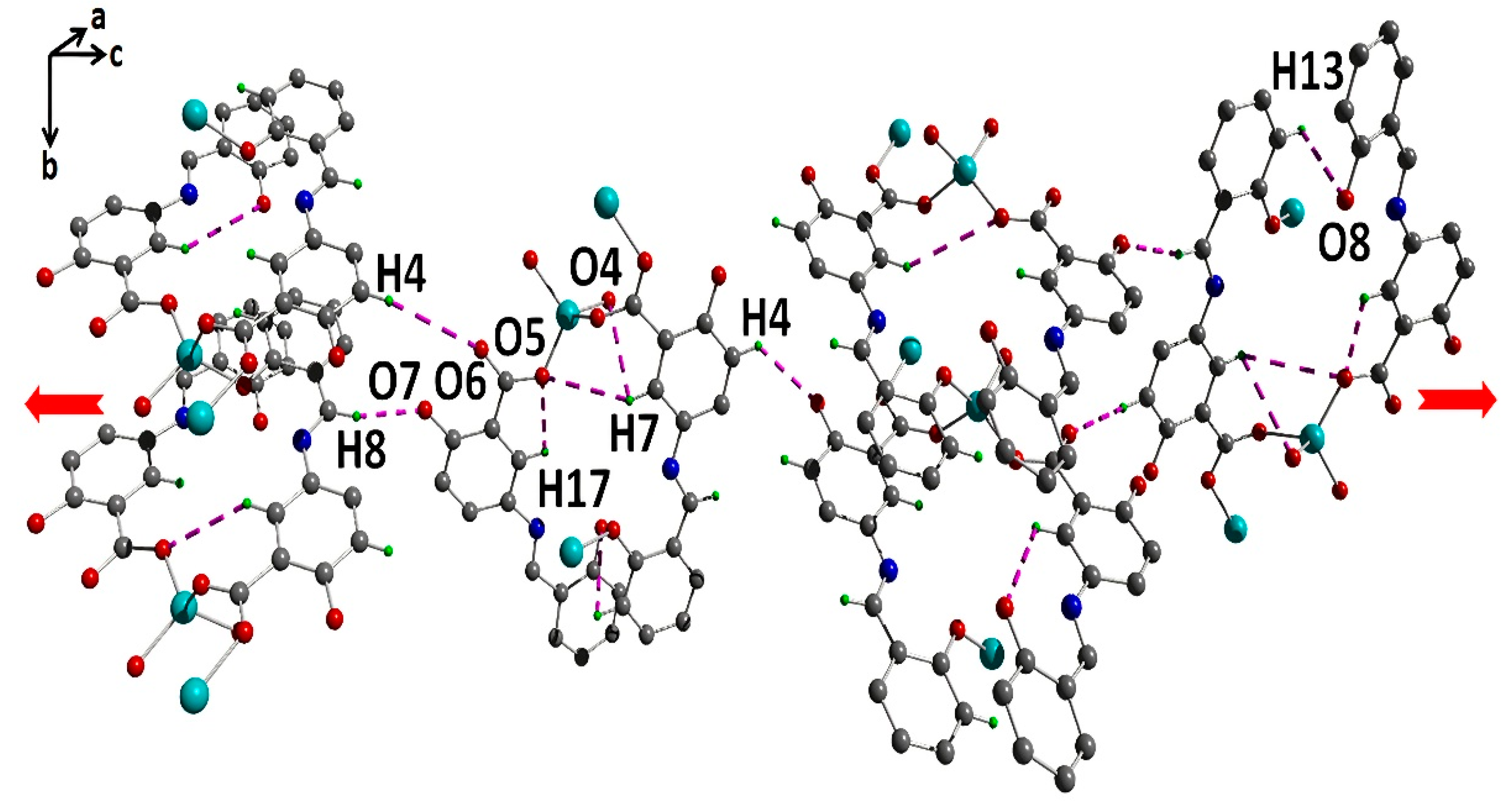

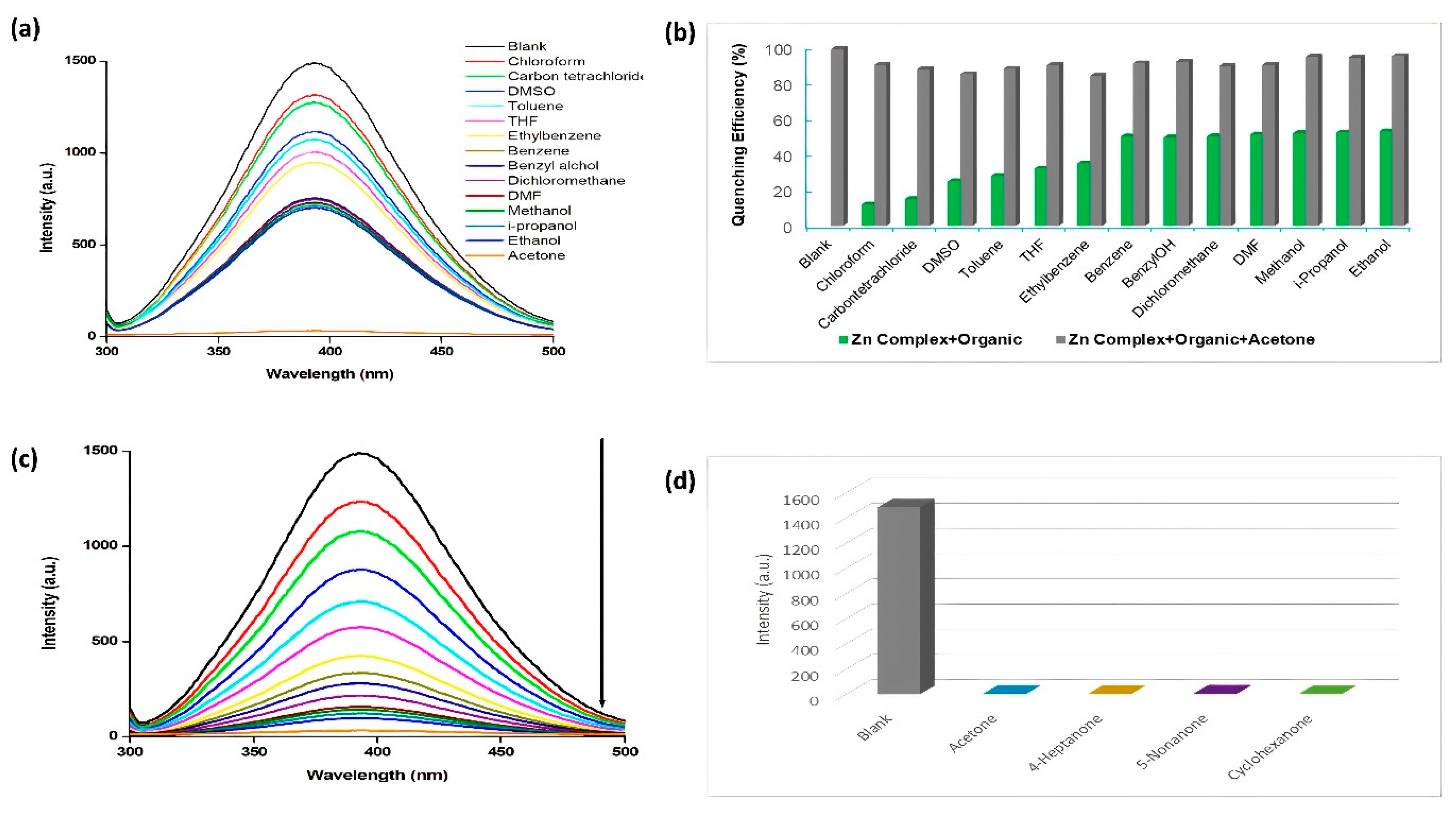
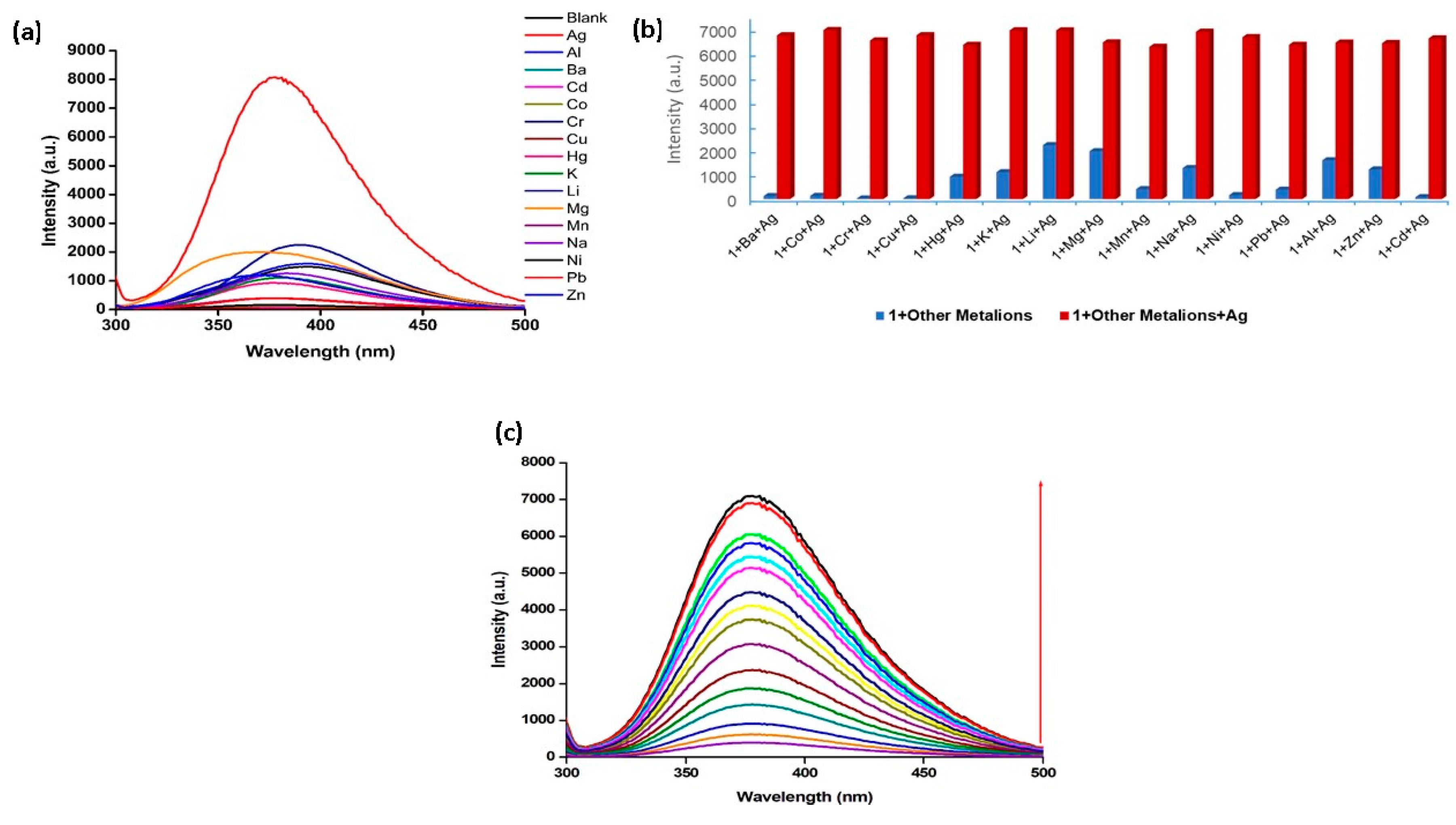

| CCDC Number | 1974273 | |
| Empirical formula | C28H20N2O8Zn | |
| Formula weight | 577.83 | |
| Temperature | 150 (2) K | |
| Wavelength | 0.71073 Å | |
| Crystal system | Monoclinic | |
| Space group | P 21/n | |
| Unit cell dimensions | a = 16.386 (5) Å | α = 90° |
| b = 6.2462 (10) Å | β = 107.669° | |
| c = 24.188 (6) Å | γ = 90° | |
| Volume | 2358.9 (10) Å3 | |
| Z | 4 | |
| Density (calculated) | 1.627 Mg/m3 | |
| Absorption coefficient | 1.101 mm−1 | |
| F(000) | 1184 | |
| Crystal size | 0.440 × 0.030 × 0.020 mm | |
| Theta range for data collection | 2.5768 to 28.3260° | |
| Index ranges | −21 ≤ h ≤ 21, −8 ≤ k ≤ 7, −32 ≤ l ≤ 32 | |
| Reflections collected | 9984 | |
| Independent reflections | 5830 (R(int) = 0.0513) | |
| Completeness to theta = 25.242° | 99.7% | |
| Absorption correction | Multi-scan | |
| Max. and min. transmission | 0.978 and 0.643 | |
| Refinement method | Full-matrix least-squares on F2 | |
| Data/restraints/parameters | 5830/568/491 | |
| Goodness-of-fit on F2 | 1.056 | |
| Final R indices (I > 2sigma(I)) | R1 = 0.0513, wR2 = 0.0884 | |
| R indices (all data) | R1 = 0.0864, wR2 = 0.0990 |
Disclaimer/Publisher’s Note: The statements, opinions and data contained in all publications are solely those of the individual author(s) and contributor(s) and not of MDPI and/or the editor(s). MDPI and/or the editor(s) disclaim responsibility for any injury to people or property resulting from any ideas, methods, instructions or products referred to in the content. |
© 2023 by the authors. Licensee MDPI, Basel, Switzerland. This article is an open access article distributed under the terms and conditions of the Creative Commons Attribution (CC BY) license (https://creativecommons.org/licenses/by/4.0/).
Share and Cite
Muddassir, M.; Alarifi, A.; Abduh, N.A.Y.; Saeed, W.S.; Karami, A.M.; Afzal, M. Multifunctional Zn(II) Coordination Polymer as Highly Selective Fluorescent Sensor and Adsorbent for Dyes. Int. J. Mol. Sci. 2023, 24, 8512. https://doi.org/10.3390/ijms24108512
Muddassir M, Alarifi A, Abduh NAY, Saeed WS, Karami AM, Afzal M. Multifunctional Zn(II) Coordination Polymer as Highly Selective Fluorescent Sensor and Adsorbent for Dyes. International Journal of Molecular Sciences. 2023; 24(10):8512. https://doi.org/10.3390/ijms24108512
Chicago/Turabian StyleMuddassir, Mohd., Abdullah Alarifi, Naaser A. Y. Abduh, Waseem Sharaf Saeed, Abdulnasser Mahmoud Karami, and Mohd. Afzal. 2023. "Multifunctional Zn(II) Coordination Polymer as Highly Selective Fluorescent Sensor and Adsorbent for Dyes" International Journal of Molecular Sciences 24, no. 10: 8512. https://doi.org/10.3390/ijms24108512
APA StyleMuddassir, M., Alarifi, A., Abduh, N. A. Y., Saeed, W. S., Karami, A. M., & Afzal, M. (2023). Multifunctional Zn(II) Coordination Polymer as Highly Selective Fluorescent Sensor and Adsorbent for Dyes. International Journal of Molecular Sciences, 24(10), 8512. https://doi.org/10.3390/ijms24108512








